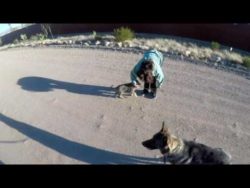Leash Training does not have to be a hassle if it is started early on in a puppy’s life.
Before we attach a leash to the dog, it is highly recommended that he has been properly introduced to wearing a collar that fits fairly snug. Putting the collar on and taking it off should be practiced as much as possible. The procedure should be wisely trained. Do not leave any collar on while the dog is unobserved and left in a crate or kennel run! There is always a chance (even though you would not think so!) that he can hang himself!
To get started with leash training, we need to associate the sight of the leash with something positive. It can be the treat or the toy. Just looking at the leash is followed with something exciting. If the dog is taken on walks that are fun, it might make a positive association just by putting the leash on and take him out immediately. If putting the leash onto the collar is somewhat of a struggle, you take much smaller increments. Showing the leash- treat. Putting the leash close to his neck- treat. Finally hooking the snap to the collar- lots of treats. That will make him want to stay in close proximity of you and prevents him from trying to run away from the possibly uncomfortable small struggle it some times creates when hooking him up.
Being in close proximity to the trainer, not pulling on the leash while standing still, is the first thing to do. Once the dog shows more interest in you than moving forward, slowly start to walk. When tension comes into the leash, he might fight in the opposite direction. Just give in! If you oppose and bring tension toward you, the dog will fight even more.Do not let him succeed into freedom by slipping out of the collar. That would be very reinforcing for the wrong behavior. Once he has given up the “bucking Bronco”- behavior, give it a moment of standing still before you start moving forward slowly. If you decide to reinforce positively you balance reinforcement provided for “going forward with you-and standing still” . That will make a better association of “paying attention to you is the specific behavior, and not moving forward nor standing still.

